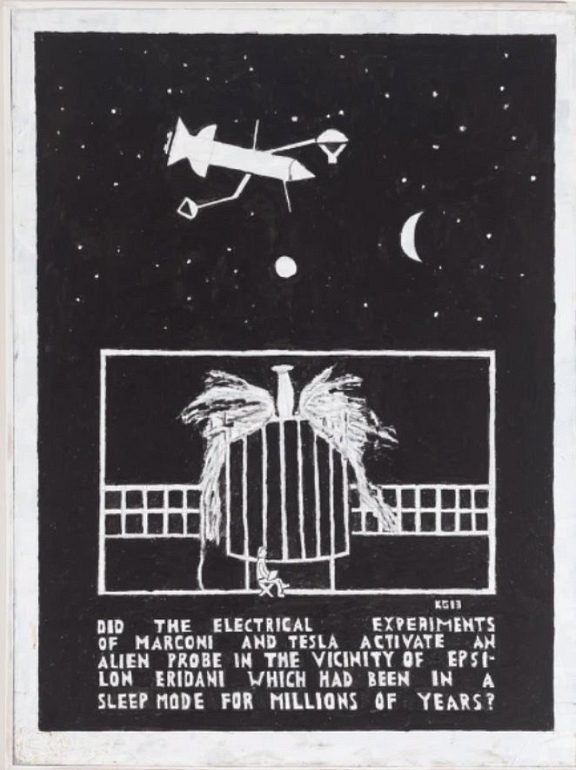
Ken Grimes
Untitled (The Electrical Experiments of Marconi).
Ken Grimes’s pieces in “The Truth Is Out There” partake of the style of cartoons, woodblocks, and also — thanks to the associations from the X‑Files reference in the title — the illustrations on the covers of the Golden Records aboard the deep space exploration vehicles Voyagers 1 and 2. Those contain information for any aliens that might find the record, starting with instructions on how to play the music and proceeding to a diagram showing the location of the origin of the mission, that is, us.
Grimes’s work shares that sense of playful seriousness. It muses aloud whether scientific experiments activated a distant alien probe, the tone of voice making room for wonder, conspiracy, and the skeptical response to both: Probably not. And so what if it did? The inherent humor allows for it all — yet in its dogged focus on its subject matter, puts its thumb on the scale. Grimes hears the skeptics. But what if there’s life out there? When it makes contact, how do we respond?
“The Truth Is Out There” is one of three solo shows up at the Ely Center of Contemporary Art on Trumbull Street, running now through Jan. 14. In addition to Grimes’s show, the gallery is hosting Desmond Beach’s “Threads of Memory” and Andree Brown’s “Leaves of Durham.” Though about radically different subject matter, they each have in common a sense of exploration, of finding out, resulting in a view of everyday life that seems suffused with energy and meaning.
“Grimes’ show at ECOCA overlaps with his latest show at NYC Gallery Ricco Moresca, ‘Evidence for Contact,’ which coincides with the release of his book of the same title,” an accompanying note explains. “Grimes’ work focuses on the question of extraterrestrial life, a topic he has been focused on for most of his life due to a series of coincidences which he interpreted as messages from aliens. Grime’s work has primarily been black and white and so his paintings demand careful consideration yet also play with fantasy, indeed making the viewer question the possibility of life out there.”
This is catnip to anyone enjoying the present era of resurgence of interest in UFOs, sparked by the release of videos a few years ago from the U.S. military of flying objects U.S. Navy pilots encountered that they can’t explain; people who are perhaps Carl Sagan fans and agree with the math that, given the enormity of the universe, the chances of life elsewhere in it might actually be pretty good; and people who just like old science-fiction movies like The Day the Earth Stood Still. But the Grimes pieces are also just plain fun, even for the most skeptical, and their placement in the foyer of the building, then leading up the stairs to the second floor, entices the viewer to see what’s next.

Desmond Beach
Birdsong.
On the second floor, a large room is taken up by Desmond Beach’s “Threads of Memory.” “Beach uses quilting and portraiture as a means to connect with the what it means to be Black in America,” an accompanying statement reads, quoting from Beach directly: “My work is rooted in the rich tradition of African storytelling, a thread that runs through each piece I create. My ancestors and those of the African Diaspora are honored in my work, and through performance and installation art, I build sacred spaces for their souls to rest. My ultimate goal as an artist is to transform the horrific into the beautiful, to take the pain and trauma of the Black experience and turn it into something that inspires and uplifts. Recent and historical events related to the African-American experience and anti-Blackness inspire my work, driving me to explore these themes in new and thought-provoking ways.”
That sense of energy and change crackles in each of Beach’s pieces. The altar he has installed turns the gallery into a sacred space that also feels rich with possibilities for exploration. In his quilts, he uses repeating patterns and interlocking shapes to create a sense that all is in flux. The transformation in Birdsong, for example, could be happening in either direction — a woman into a bird or a bird into a woman. It invokes ideas of ancestry and of drawing strength to fly. Either way, it’s a message of strength and hope.

Meanwhile, Andree Brown has brought the outside in, turning another room on ECOCA’s second floor into a small forest. “Brown’s sculptures are organic, abstract, and influenced by forms she finds outside,” an accompanying note states. “Brown is playful with form and scale, taking liberties with both. Brown’s inspiration came from leaves she foraged in the woods of Durham, CT and has defined their character and given them voice.… Brown uses her sculptures as a means to connect with the natural world and learn how trees communicate with each other and us.”
In a way dovetailing with Grimes, Brown creates plantlike forms that in their shape and size might seem like they belong on another planet. But their scale is inviting too; they let the viewer come up close and easily see detail. In that way, they are perhaps training people for a walk in the woods not far from their own doors, training them to not just follow a trail, but to stop and linger, get up close to whatever facet of riotous life might catch their eye — even in December. For all three artists, there’s movement everywhere, if you know how to look.